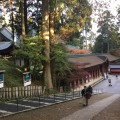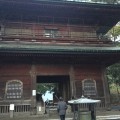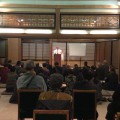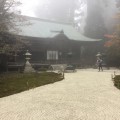檀信徒さんたちと比叡山延暦寺を参拝。国宝・根本中堂、浄土院などの諸堂を廻るとともに千日回峰行者の藤波源信阿闍梨さまからご法話とお加持を頂いた。先日テレビなどで「堂入り」の様子が放映されていたが、過去にこの修行を達成された阿闍梨さまから、直にお話をお聞きできて皆さん感動されたようすだった。
*「千日回峰行」とは、比叡山で7年間かけて行われる修行で、歩きながら礼拝を行う三昧行。毎年3月末から連続して100日の間(あるいは200日)、一日も休まず約40キロを歩く。距離は年により異なるが、最長で80キロにもなる。1000日間で約4万キロ(地球1周分)にも及ぶ。
*「堂入り」とは、「千日回峰行」の700日目から始まり、不動明王と一体となることを目指す修行。比叡山中の明王堂にこもり9日間、断食、断水、不眠、不臥で不動真言10万回を唱える最大の難行。
I visited Hieizan Enryaku-Ji temple with my “Danka”, a supporting member family of my temple. Hieizan Enryaku-Ji temple, the head temple of the Tendai buddhist sect, is considered to a special position as “Mother of Japanese buddhism” in Japanese Buddhism.
In this time, we met a special monk practicing “Thousand-Day Circumambulation Practice” which is called “Sennichi-Kaihōgyō”(千日回峰行)in Japanese. This monk is well known for foreigners as “marathon monk”. I think this practice might be the harshest practice in Japan.
This practice, “Kaihōgyō” is 1,000 days of walking meditation and praying over a seven-year period around Mount Hieizan. The Monk of”Kaihōgyō” walks 26 miles(30 km) a day for periods of either 100 or 200 consecutive days. As we normally meditate while sitting down , It may sound strange for walking meditation. But this way was done in the Chinese buddhism. And Kaihōgyō is based on Jofugyo bosatsu (The Bodhisattva Never Disparaging)in Lotus sūtra.
The training is divided into 100-day sections for 7 years. The monk walkes 40 km per day for 100 days in the first year. The second year and the third year is the same. From the fourth year to the fifth year,he walks 40 km per day for 200 days in a year. In the sixth year, 60 km per day for 100 days. In the last seventh year, 84 km per day for 100 days. The total distance is about the same as walking around the Earth.
During the fifth year of the challenge, the walking practice is punctuated. The monk must go for nine days without food, water, and sleeping or rest of any kind. He sits in the Temple and recites the Fudō Myōō, acala-nātha-buddha in sanskrit, mantra constantly. Two monks accompany him, one on either side, to ensure he doesn’t fall asleep. At 2:00 am every night, he must get up to fetch water for offering from a special well, around 200m away, as an offering for Fudō Myōō. The monk often walks with unsteady steps. When he completes this practice, he is called Dai-Ajari(大阿闍梨), which means Mahā-ācārya in Sanskrit, as an honorific title.






